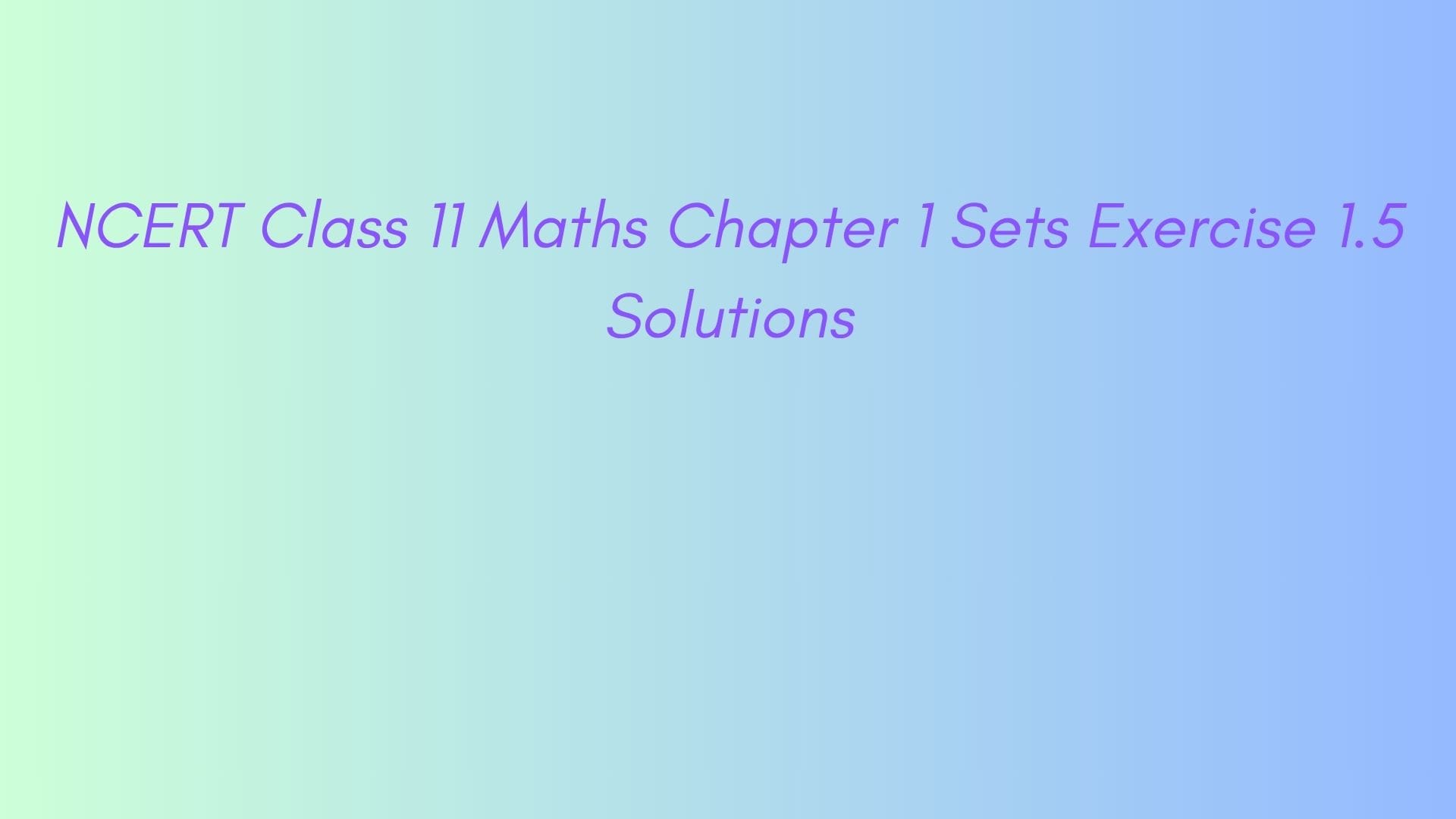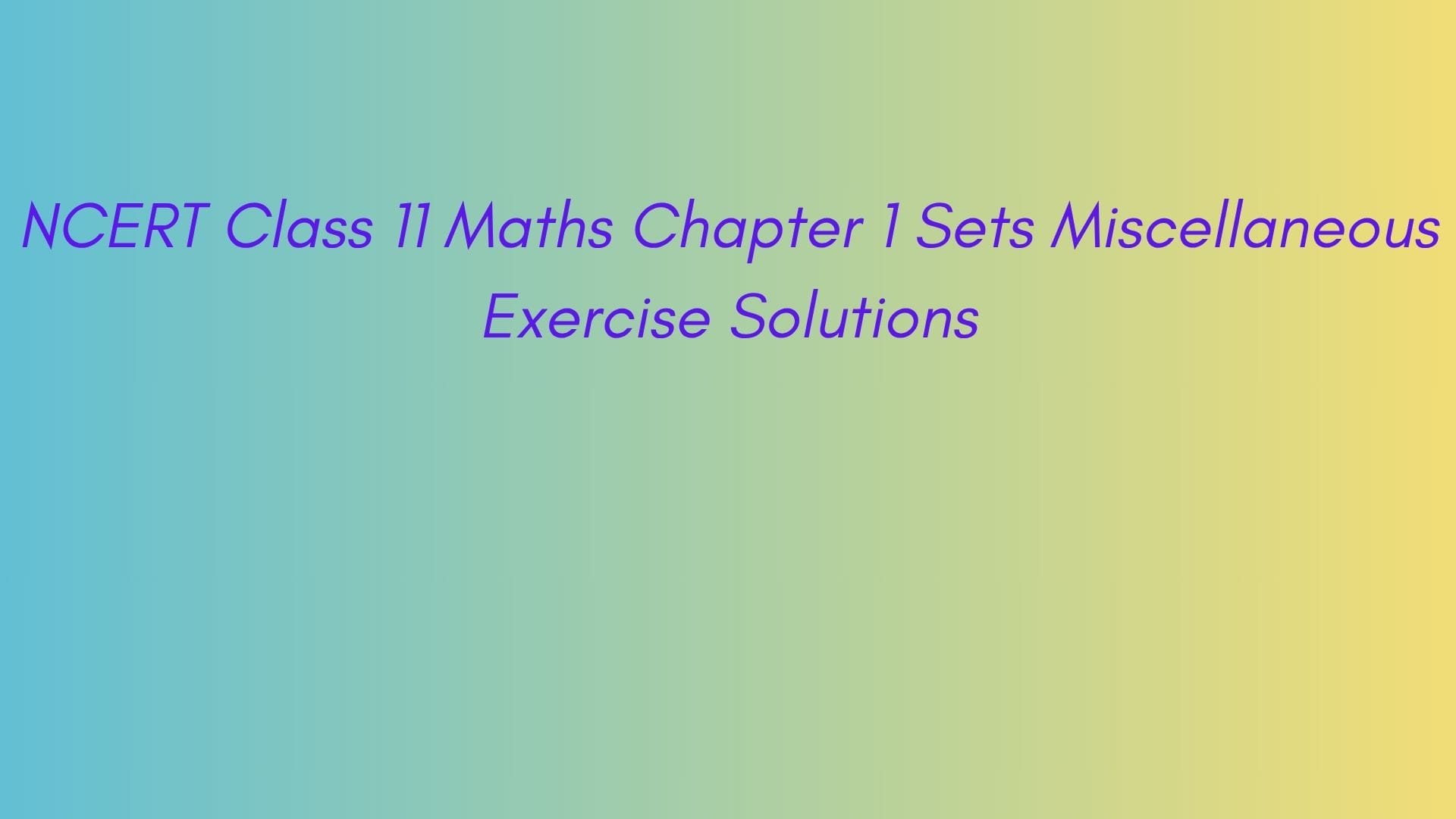Written by : Anmol Gupta
4 mins read time
NCERT Class 11 Maths Chapter 1 Sets Exercise 1.5 Solutions
Table of Contents
Solved Examples of Exercise 1.5
Example 20. Let U = {1, 2, 3, 4, 5, 6, 7, 8, 9, 10} and A = {1, 3, 5, 7, 9}. Find A′
Answer 20. A′ = U – A = {2, 4, 6, 8, 10}
Example 21. Let U be universal set of all the students of Class XI of a coeducational school and A be the set of all girls in Class XI. Find A′.
Answer 21. A′ is the set of all boys in the class
Example 22. Let U = {1, 2, 3, 4, 5, 6}, A = {2, 3} and B = {3, 4, 5}. Find A′, B′ , A′ ∩ B′, A ∪ B and hence show that ( A ∪ B )′ = A′∩ B′
Answer 22. A′ = U – A = {1,4,5,6}
B′ = U – B = {1,2,6}
A′ ∩ B′ = {1,6}
A ∪ B = {2,3,4,5}
( A ∪ B )′ = U – ( A ∪ B ) = {1,6}
Exercise 1.5 solved questions
Question 1. Let U = { 1, 2, 3, 4, 5, 6, 7, 8, 9 }, A = { 1, 2, 3, 4}, B = { 2, 4, 6, 8 } and C = { 3, 4, 5, 6 }. Find (i) A′ (ii) B′ (iii) (A ∪ C)′ (iv) (A ∪ B)′ (v) (A′)′
(vi) (B – C)′
Answer 1.
(i) A′ = U – A = { 5, 6, 7, 8, 9 }
(ii) B′ = U – B = {1, 3, 5, 7, 9}
(iii) (A ∪ C)′ = {7,8,9}
(iv) (A ∪ B)′ = {5,7,9}
(v) (A′)′ = A
(vi) (B – C)′ = {1,3,4,5,6,7,9}
Question 2. If U = { a, b, c, d, e, f, g, h}, find the complements of the following sets :
(i) A = {a, b, c} (ii) B = {d, e, f, g} (iii) C = {a, c, e, g} (iv) D = { f, g, h, a}
Answer 2.
(i) A′ = U – A = {d, e, f, g, h}
(ii) B′ = U – B = {a, b, c, h}
(iii) C′ = U – C = {b, d, f, h}
(iv) D′ = U – D = {b, c, d, e}
Question 3. Taking the set of natural numbers as the universal set, write down the complements of the following sets:
(i) {x : x is an even natural number} (ii) { x : x is an odd natural number }
(iii) {x : x is a positive multiple of 3} (iv) { x : x is a prime number }
(v) {x : x is a natural number divisible by 3 and 5}
(vi) { x : x is a perfect square } (vii) { x : x is a perfect cube}
(viii) { x : x + 5 = 8 } (ix) { x : 2x + 5 = 9}
(x) { x : x ≥ 7 } (xi) { x : x ∈ N and 2x + 1 > 10 }
Answer 3. (i) {x : x is an odd natural number} (ii) { x : x is an even natural number }
(iii) {x : x ∈ N & x is not a multiple of 3} (iv) { x : x ∈ N and x is not a prime number }
(v) {x : x is a natural number not divisible by 3 and 5}
(vi) { x : x ∈ N & x is not a perfect square } (vii) { x : x ∈ N and x is not a perfect cube}
(viii) { x : x ∈ N & x ∉ 3 } (ix) { x : x ∈ N & x ∉ 2}
(x) { x : x ∈ N & x<7 } (xi) { x : x ∈ N and x< ⁹⁄₂ }
Question 4. If U = {1, 2, 3, 4, 5, 6, 7, 8, 9 }, A = {2, 4, 6, 8} and B = {2, 3, 5, 7}. Verify that (i) (A ∪ B)′ = A′ ∩ B′ (ii) (A ∩ B)′ = A′ ∪ B′
Answer 4.
(i) A ∪ B = {2, 3, 4, 5, 6, 7, 8}
(A ∪ B)′ ={1, 9}
A′ = U – A = {1,3,5,7,9}
B′ = U – B = {1,4,6,8,9}
A′ ∩ B′ = {1,9} = (A ∪ B)′
(ii) A ∩ B = {2}
(A ∩ B)′ = U – (A ∩ B) = {1,3,4,5,6,7,8,9}
A′ U B′ = {1,3,4,5,6,7,9} = (A ∩ B)′
Question 5. Draw appropriate Venn diagram for each of the following :
(i) (A ∪ B)′, (ii) A′ ∩ B′, (iii) (A ∩ B)′, (iv) A′ ∪ B′
Answer 5.


Question 6. Let U be the set of all triangles in a plane. If A is the set of all triangles with at least one angle different from 60°, what is A′ ?
Answer 6.
A′ = U – A
A triangle with all three angles equal to 60° is an equilateral triangle.
Therefore, A = All triangles that are not equilateral (i.e., at least one angle ≠ 60°).
A′ = Set of all triangles in a plane – All triangles that are not equilateral
A′ = Set of all triangles in the plane where all angles are equal to 60°
Question 7. Fill in the blanks to make each of the following a true statement :
(i) A ∪ A′ = . . . (ii) φ′ ∩ A = . . .
(iii) A ∩ A′ = . . . (iv) U′ ∩ A = . . .
Answer 7.
(i) A ∪ A′ = U
(ii) φ′ ∩ A = U ∩ A = A
(iii) A ∩ A′ = φ
(iv) U′ ∩ A = φ ∩ A = φ

